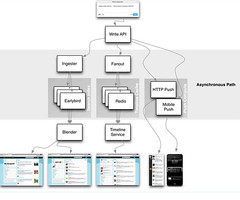The email sent will contain a link to this article, the article title, and an article excerpt (if available). For security reasons, your IP address will also be included in the sent email.

Toy solutions solving Twitter’s “problems” are a favorite scalability trope. Everybody has this idea that Twitter is easy. With a little architectural hand waving we have a scalable Twitter, just that simple. Well, it’s not that simple as Raffi Krikorian, VP of Engineering at Twitter, describes in his superb and very detailed presentation on Timelines at Scale. If you want to know how Twitter works - then start here.
It happened gradually so you may have missed it, but Twitter has grown up. It started as a struggling three-tierish Ruby on Rails website to become a beautifully service driven core that we actually go to now to see if other services are down. Quite a change.
Twitter now has 150M world wide active users, handles 300K QPS to generate timelines, and a firehose that churns out 22 MB/sec. 400 million tweets a day flow through the system and it can take up to 5 minutes for a tweet to flow from Lady Gaga’s fingers to her 31 million followers.
A couple of points stood out:
- Twitter no longer wants to be a web app. Twitter wants to be a set of APIs that power mobile clients worldwide, acting as one of the largest real-time event busses on the planet.
- Twitter is primarily a consumption mechanism, not a production mechanism. 300K QPS are spent reading timelines and only 6000 requests per second are spent on writes.
- Outliers, those with huge follower lists, are becoming a common case. Sending a tweet from a user with a lot of followers, that is with a large fanout, can be slow. Twitter tries to do it under 5 seconds, but it doesn’t always work, especially when celebrities tweet and tweet each other, which is happening more and more. One of the consequences is replies can arrive before the original tweet is received. Twitter is changing from doing all the work on writes to doing more work on reads for high value users.
- Your home timeline sits in a Redis cluster and has a maximum of 800 entries.
- Users care about tweets, but the text of the tweet is almost irrelevant to most of Twitter's infrastructure.
- Twitter knows a lot about you from who you follow and what links you click on. Much can be implied by the implicit social contract when bidirectional follows don’t exist.
- It takes a very sophisticated monitoring and debugging system to trace down performance problems in a complicated stack. And the ghost of legacy decisions past always haunt the system.
How does Twitter work? Read this gloss of Raffi’s excellent talk and find out...














 Return to Article
Return to Article